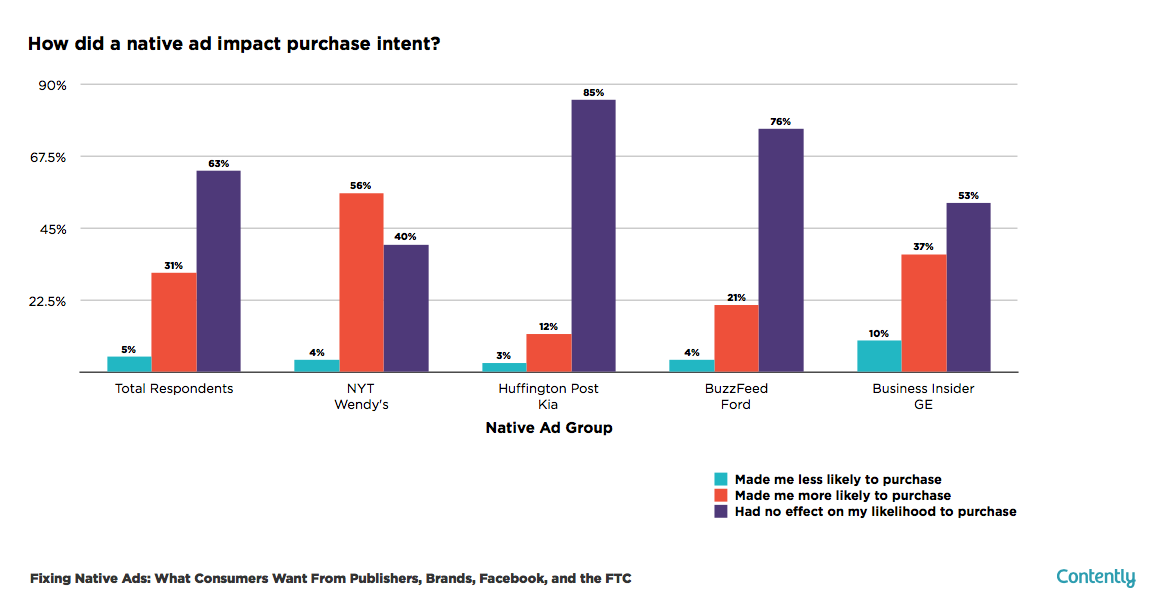When it comes to digital advertising, a “big four” have emerged: social ads, display ads, video ads, and native advertising. The Daily Beast now gets 90 percent of its ad revenue from native ads. Will consumers be able to identify the sponsor? More than half of respondents felt deceived after figuring out they read content sponsored by a brand. For instance, the most clearly labeled native ad in our study—a New York Times paid post promoting the freshness of Wendy’s food—was also the most effective. Eighty-three percent of readers were able to identify Wendy’s as the sponsor, and 56 percent were more likely to purchase Wendy’s after reading the promotional content. Tell a story about your brand, as long as you tell it well There’s a consensus out there that suggests consumers are averse to native content that focuses on the sponsor. The New York Times native ad with Wendy’s was by far the most brand-centric and promotional of the four ads we tested. As a result, publishers may also be able to achieve better CPCs when they promote content on Facebook on behalf of brands, as opposed to letting brands promote content on their own. The risk here is that publishers will just purchase traffic from the cheapest audience possible, not the audience that the advertiser wants.
When it comes to digital advertising, a “big four” have emerged: social ads, display ads, video ads, and native advertising. According to a Salesforce survey of 4,000 marketers, native advertising is currently the third-most popular tactic, tied with video.

Native advertising has come a long way since The Atlantic was shilling for Scientology and giving Jeff Jarvis a panic attack on Twitter. The New York Times—a late entrant into the native ad game in January 2014—has grown its native ad shop, T Brand Studio, into a 100-employee operation that pursues full-service agency deals. The Daily Beast now gets 90 percent of its ad revenue from native ads. Most brands have made native advertising a key part of their repertoire—even as the price tag goes up.
At top publishers like The New York Times and BuzzFeed, a native ad campaign costs at least $100,000, which begs the question: Are brands justifying their investment and doing native advertising right?
That was a key question we wanted to answer this fall when we conducted an in-depth study on native advertising with the Tow-Knight Center for Entrepreneurial Journalism at CUNY. Through focus groups and a survey of 1,212 consumers, we pinpointed some big problems with native content, but also discovered how it can deliver big benefits to advertisers.
Below are a few ways that brands can make their native advertising more effective in 2017.
1. Insist upon clear labeling
Although native advertising has an ancestor in the advertorials that ran decades ago in print magazines, the current ads that appear on publisher sites have a unique format. As the FTC’s native ad guidelines state: “In digital media, native ads often resemble the design, style, and functionality of the media in which they are disseminated.”
The fact that native ads often resemble the surrounding editorial presents potential downsides. Will consumers be able to identify the sponsor? Will they feel deceived? Will they still trust the publisher?
These concerns are legitimate. More than half of respondents felt deceived after figuring out they read content sponsored by a brand.

Some native advertising critics argue this is by design—brands stand to benefit the most from consumers who read a positive article about a company without realizing it’s sponsored. But as our study makes clear, brands have little to lose if they push for clearer labeling. For instance, the most clearly labeled native ad in our study—a New York Times paid post promoting the freshness of Wendy’s food—was also the most effective. Eighty-three percent of readers were able to identify Wendy’s as the sponsor, and 56 percent were more likely to purchase Wendy’s after reading the promotional content.

COMMENTS